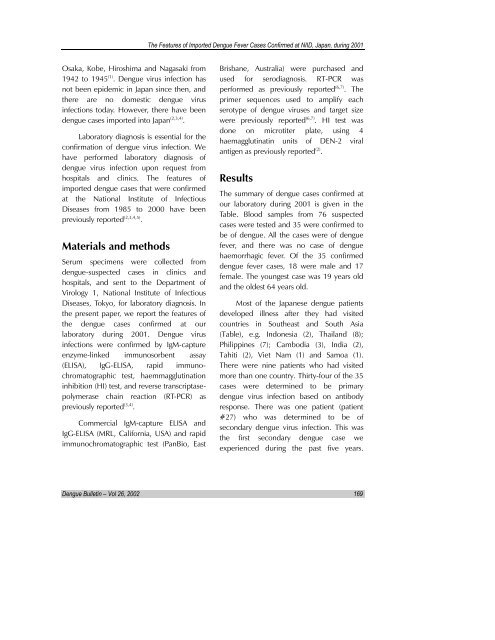Dengue Bulletin
Dengue Bulletin
Dengue Bulletin
- TAGS
- dengue
- bulletin
- 203.90.70.117
You also want an ePaper? Increase the reach of your titles
YUMPU automatically turns print PDFs into web optimized ePapers that Google loves.
Osaka, Kobe, Hiroshima and Nagasaki from<br />
1942 to 1945 (1) . <strong>Dengue</strong> virus infection has<br />
not been epidemic in Japan since then, and<br />
there are no domestic dengue virus<br />
infections today. However, there have been<br />
dengue cases imported into Japan (2,3,4) .<br />
Laboratory diagnosis is essential for the<br />
confirmation of dengue virus infection. We<br />
have performed laboratory diagnosis of<br />
dengue virus infection upon request from<br />
hospitals and clinics. The features of<br />
imported dengue cases that were confirmed<br />
at the National Institute of Infectious<br />
Diseases from 1985 to 2000 have been<br />
previously reported (2,3,4,5) .<br />
Materials and methods<br />
Serum specimens were collected from<br />
dengue-suspected cases in clinics and<br />
hospitals, and sent to the Department of<br />
Virology 1, National Institute of Infectious<br />
Diseases, Tokyo, for laboratory diagnosis. In<br />
the present paper, we report the features of<br />
the dengue cases confirmed at our<br />
laboratory during 2001. <strong>Dengue</strong> virus<br />
infections were confirmed by IgM-capture<br />
enzyme-linked immunosorbent assay<br />
(ELISA), IgG-ELISA, rapid immunochromatographic<br />
test, haemmagglutination<br />
inhibition (HI) test, and reverse transcriptasepolymerase<br />
chain reaction (RT-PCR) as<br />
previously reported (3,4) .<br />
Commercial IgM-capture ELISA and<br />
IgG-ELISA (MRL, California, USA) and rapid<br />
immunochromatographic test (PanBio, East<br />
The Features of Imported <strong>Dengue</strong> Fever Cases Confirmed at NIID, Japan, during 2001<br />
Brisbane, Australia) were purchased and<br />
used for serodiagnosis. RT-PCR was<br />
performed as previously reported (6,7) . The<br />
primer sequences used to amplify each<br />
serotype of dengue viruses and target size<br />
were previously reported (6,7) . HI test was<br />
done on microtiter plate, using 4<br />
haemagglutinatin units of DEN-2 viral<br />
antigen as previously reported (2) .<br />
Results<br />
The summary of dengue cases confirmed at<br />
our laboratory during 2001 is given in the<br />
Table. Blood samples from 76 suspected<br />
cases were tested and 35 were confirmed to<br />
be of dengue. All the cases were of dengue<br />
fever, and there was no case of dengue<br />
haemorrhagic fever. Of the 35 confirmed<br />
dengue fever cases, 18 were male and 17<br />
female. The youngest case was 19 years old<br />
and the oldest 64 years old.<br />
Most of the Japanese dengue patients<br />
developed illness after they had visited<br />
countries in Southeast and South Asia<br />
(Table), e.g. Indonesia (2), Thailand (8);<br />
Philippines (7); Cambodia (3), India (2),<br />
Tahiti (2), Viet Nam (1) and Samoa (1).<br />
There were nine patients who had visited<br />
more than one country. Thirty-four of the 35<br />
cases were determined to be primary<br />
dengue virus infection based on antibody<br />
response. There was one patient (patient<br />
#27) who was determined to be of<br />
secondary dengue virus infection. This was<br />
the first secondary dengue case we<br />
experienced during the past five years.<br />
<strong>Dengue</strong> <strong>Bulletin</strong> – Vol 26, 2002 169









